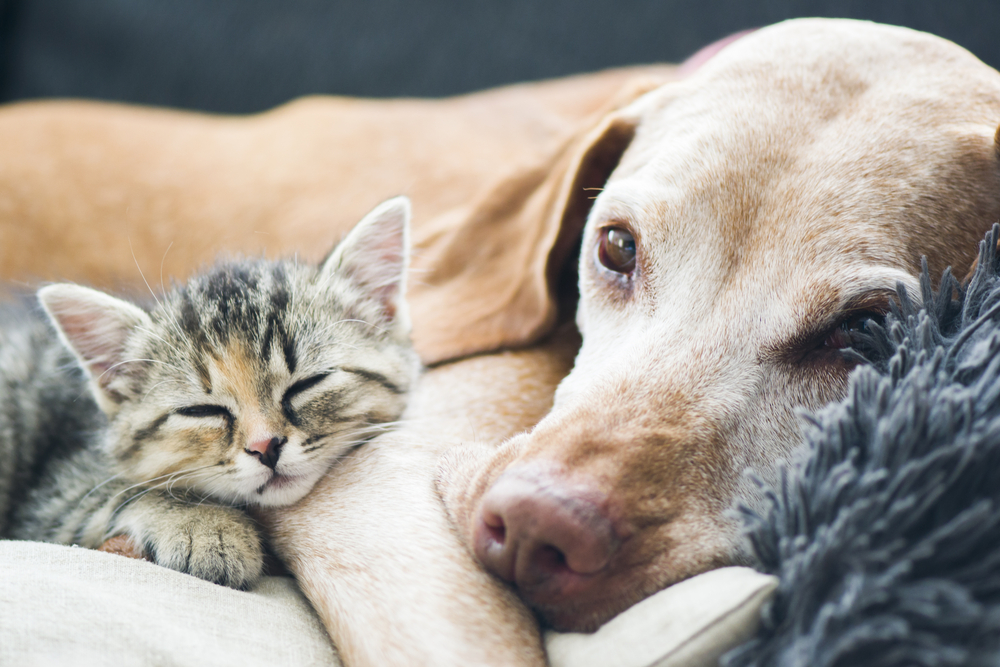If you were to go by all the talk about “dog people” versus “cat people,” you’d think that everyone had to choose one and stick to it. They don’t, of course; plenty of us have both cats and dogs and despite their differences, it seems to work out. If you want to ensure a good relationship, though, science says to focus on the cat’s needs.
A recent study surveyed owners mostly in the United Kingdom and the United States, asking detailed questions about how their cats and dogs got along. The majority of the 748 owners thought their pets had pretty good relationships. On a scale of 1 to 10 where 1 was “can’t stand each other” and 10 was “close companions,” few ratings of 4 and below were found.
However, while there were some pets that sometimes played together or groomed one another – some even shared food, toys, or beds – those best-buddy scores of 9 and 10 were also rare. This suggests that we need to be careful not to have overly romanticized expectations of cat-dog relationships.
“I think people probably have an ideal that they want them to cuddle up together and share things because that’s sweet and cute,” says Zazie Todd, PhD, author of the website Companion Animal Psychology and the Psychology Today blog Fellow Creatures. “But if they’re safe with each other, if they’re not fighting and stressed out by each other, that’s good enough.”
Nurturing relationships
If you want your pets to get along – even with slightly lowered expectations – one thing this study showed was that you may need to pay more attention to the cat. The best relationships were those where owners rarely thought the cat appeared to be uncomfortable with the dog – it didn’t seem to matter as much if the dog was sometimes uneasy. And though aggression was rare, it was mostly from the cats toward the dog. On the one hand that’s a good thing, since dogs are usually larger and could do more damage. But it means the cat is trying to tell you something.
“Aggression from cat toward dog probably shows the cat is feeling threatened because the dog’s too close and the cat is saying he needs a bit more space,” says Todd. “If there’s signs of aggression, you need to do something to help them get along a bit better.”
What can you do? In the moment, encourage the dog to back off, but in the long term you want to help prevent conflicts from arising in the first place. One thing to keep in mind is that dogs chasing cats is not an unchangeable fact of nature – training absolutely will help.
“You need to think about whether the dog is a serious threat to the cat – if the dog has a history of attacking small animals and killing them, you can’t expect to train that out,” says Todd. “But even if your dog is friendly to the cat, it might still be annoying to the cat from the cat’s perspective.”
Conflict avoidance tips
It is possible to train a dog in a positive way not to chase and bother cats, and the idea is pretty simple – you reward the dog for doing something else instead. This simple idea can be difficult to execute if you don’t have experience, though, so you may need the help of a qualified trainer or behaviorist. But you should also be doing something simpler: giving the cat easy ways to avoid confrontation.
“A lot of it is about setting up the environment so the cat has places where they can feel safe – providing high places where the cat can go and be out of reach of the dog, or places underneath or behind things where the dog can’t go,” says Todd. “It’s important to provide those spaces where the cat can take themselves away if they want to.” Along with tall cat trees, Todd suggests that if you have a large dog, you can do things like pull the sofa away from the wall and put a cat bed behind it, creating a private den-like space the dog can’t get to.
Family planning
The study also found that relationships were more likely to be good when the cat was young when first introduced to the dog. You can’t go back and change that, but you can think about it when considering adding another pet to the family.
Getting a kitten to go with an existing dog isn’t the only possibility. Remember that not all cats and dogs are the same – there are individual differences in their temperament and past experience – so choose with that in mind.
“If you’re adopting an older cat from a shelter, they will usually know something about whether the cat is good with dogs or not. That will help you in choosing the cat,” says Todd. “If you already have the cat in your home and you’re bringing in an older dog, you should be able to find out first if the dog is good with other animals or not.”
If you’re bringing in a puppy, start from the beginning to socialize and teach the youngster not to bother the cat. Again, set up your home for success.
“Set up the environment so the cat has lots of space to themselves where they can get away from the dog if they want to, so the dog’s not going to come and eat their food because it’s somewhere inaccessible,” says Todd. “All those things will help to make it work out.”
This article was reviewed/edited by board-certified veterinary behaviorist Dr. Kenneth Martin and/or veterinary technician specialist in behavior Debbie Martin, LVT.








